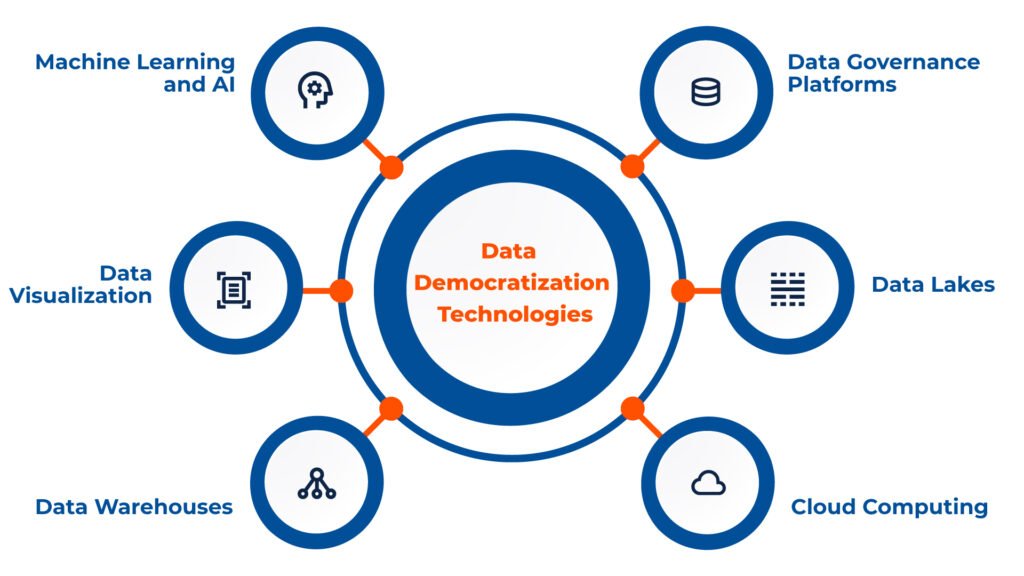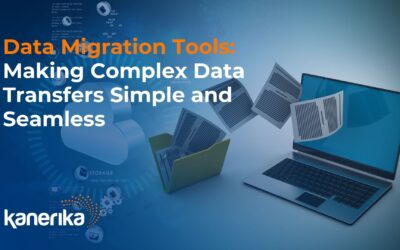Ever wondered how organizations are accessing and analyzing vast amounts of data? How are they transforming their approach to data accessibility? Many organizations struggle with siloed data, complex data structures, and a lack of tools that make data accessible to their employees.
Recent studies show that most of the employees spend the majority of their time searching for information or struggling to access and interpret data. As per the report by Mckinsey, employees spend an average of 1.8 hours each day, totaling 9.3 hours per week, searching for and collecting information. Data democratization can address these challenges.
Data democratization is the process of making data accessible to everyone in an organization, regardless of their technical expertise. With the increasing dependency on data-driven decision-making, companies these days are leveraging data democratization to access and make sense of data that is available in numerous forms.
Data democratization tools come in many forms, including data visualization tools, data analysis tools, and data management tools. They often feature user-friendly interfaces and require little to no technical expertise to use.
Table of Contents
- What is Data Democratization?
- Why do Enterprises Need Data Democratization Tools?
- Popular Data Democratization Technologies
- Tools Enabling Data Democratization in Organizations
- Role of Data Democratization in Creating a Data-Driven Culture
- Advantages of Data Democratization
- Steps to Get Started with Data Democratization
- Challenges in Implementing Data Democratization
- Flip: Empowering Enterprises through Data Democratization
- Trust Kanerika to Address Your Data Accessibility Challenges
- FAQs
What is Data Democratization?

Data democratization involves removing the technical barriers that prevent users from accessing and analyzing data. By democratizing data, organizations can empower non-technical users to make more informed decisions and contribute to the overall success of the organization.
Today, there are a variety of data democratization tools available to help organizations overcome these challenges. These tools range from simple data visualization software to more complex data analytics platforms.
Some of the most popular data democratization tools include Flip, Tableau, Looker, and Power BI. These tools allow users to easily create and share data visualizations, explore data sets, and collaborate with team members. With the right data democratization tools in place, organizations can empower all employees to make data-driven decisions and drive business growth.
Read More – 6 Core Data Mesh Principle for Seamless Integration
Why do Enterprises Need Data Democratization Tools?
By implementing data democratization tools, employees will be empowered to access and analyze data on their own, without relying on IT or data analysts. This not only saves time and resources, but also allows for faster decision-making and a more agile business strategy.
Data democratization tools also promote transparency and collaboration within your organization. With everyone having access to the same data, it becomes easier to identify patterns and trends, and to make data-driven decisions as a team.
These tools can help you stay compliant with regulations such as GDPR and CCPA. By providing a centralized platform for managing data access and permissions, you can ensure that sensitive information is only accessible to authorized personnel.

Popular Data Democratization Technologies
Data democratization has become an essential aspect of modern business. Several technologies have enabled data democratization, making it possible for organizations to leverage data to make informed decisions. Here are some of the key technologies that have made data democratization possible:
Data Warehouses
These are centralized repositories that store data from various sources. They provide a unified view of an organization’s data, making it easier for business users to access and analyze data. Data warehouses are designed to support complex queries and reporting, making them ideal for data democratization. They provide a secure and scalable environment for data analysis, enabling organizations to make informed decisions.

Data Lakes
They are similar to data warehouses, but they store both structured and unstructured data. They are designed to store large volumes of data from various sources, making it easier for organizations to analyze data. Data lakes provide a flexible and scalable environment for data analysis, making them ideal for data democratization. They enable business users to access and analyze data without relying on IT specialists.
Machine Learning and AI
Machine learning and AI have made it possible for organizations to automate data analysis. These technologies enable organizations to build predictive models and identify patterns in data. They provide insights that would be difficult to obtain using traditional analysis methods. Machine learning and AI automation make it possible for business users to analyze data without relying on IT specialists.
Data Visualization
Data visualization tools make it easier for business users to understand and analyze data. They provide visual representations of data, making it easier to identify patterns and trends. Data visualization tools enable business users to create interactive dashboards and reports, making it possible to explore data in real-time. They provide a user-friendly interface for data analysis, making it easier for business users to access and analyze data.
Cloud Computing
Cloud computing services provide a flexible and scalable environment for data analysis. They enable organizations to store and analyze data without investing in expensive hardware and software. Cloud computing services provide a cost-effective solution for data democratization, making it possible for organizations of all sizes to leverage data to make informed decisions.
Data Governance Platforms
Data governance platforms provide a framework for managing data assets. They enable organizations to define policies and procedures for data management, ensuring that data is accurate, consistent, and secure. Data governance platforms provide a centralized view of an organization’s data, making it easier to manage data assets. They provide a secure and compliant environment for data analysis, making it possible for business users to access and analyze data without compromising data security.
Also read: Unlocking Strategic Advantages with Data Visualization
Tools Enabling Data Democratization in Organizations
Tableau
Tableau is a powerful data visualization tool that transforms raw data into interactive and shareable visual insights. It simplifies complex datasets, allowing users to create dashboards and reports, fostering informed decision-making.
Power BI
Microsoft’s Power BI is a comprehensive business intelligence platform that helps users to connect, analyze, and visualize data from various sources. With robust reporting capabilities, Power BI facilitates data-driven decision-making across organizations.
Looker
Looker is a data exploration and business intelligence platform that creates a unified data environment. It promotes collaboration by providing a single source of truth for organizations, making data analysis and reporting more cohesive.
QlikView/Qlik Sense
QlikView and Qlik Sense leverage associative data modeling to enable intuitive exploration, visualization, and analysis. Users can uncover hidden patterns and insights in their data, fostering a deeper understanding of business dynamics.
Alteryx
Alteryx is a data preparation and blending tool that streamlines the analytics process. It offers a user-friendly interface for data cleansing, blending, and predictive analytics, empowering users to derive actionable insights without extensive coding.
Domo
Domo is a cloud-based business intelligence platform that simplifies data integration, visualization, and collaboration. It provides real-time insights, fostering agile decision-making and improved organizational performance.
Sisense
Sisense is a scalable business intelligence platform that utilizes in-memory technology for rapid analysis of large datasets. It converts complex data into actionable insights, facilitating effective decision-making and business optimization.
DataRobot
DataRobot is an automated machine learning platform that enables users to build, deploy, and manage machine learning models without extensive coding. It accelerates the adoption of artificial intelligence across organizations by making advanced analytics more accessible.
Sigma Computing
Sigma Computing is a cloud-native business intelligence tool that allows users to directly explore and analyze data within cloud data warehouses. It promotes faster and collaborative data-driven decision-making by providing a seamless platform for data exploration and visualization.
Role of Data Democratization in Creating a Data-Driven Culture
Data democratization involves breaking down data silos and empowering non-technical users to access and analyze data on their own. It can help create a data-driven culture within an organization. By making data more accessible, everyone in the organization has the opportunity to use data to inform their decisions and actions. This can lead to more informed decision-making, improved collaboration, and better outcomes.

To create a data-driven culture, it’s important to provide the right tools and resources to support data democratization. This might include self-service analytics tools, data visualization tools, and training programs to help users develop the skills they need to work with data effectively.
Another important aspect of creating a data-driven culture is to foster a sense of data literacy throughout the organization. This means helping users understand how to use data effectively, how to interpret data correctly, and how to communicate insights to others.
Check out: Data Lineage: Types, benefits, and classifications
Advantages of Data Democratization
1. Increased Collaboration
Data democratization tools enable teams to collaborate more effectively. By giving everyone access to the same data, teams can work together to solve problems and make data-driven decisions. This approach can lead to more innovative solutions, as team members can bring their unique perspectives to the table.
2. Improved Decision Making
By providing access to data, decision-makers can get a more complete picture of the situation and make more informed choices. This approach can lead to better outcomes, as decisions are based on data rather than assumptions or guesswork.

3. Increased Productivity
Data democratization can also increase productivity. By making data more accessible, employees can spend less time searching for information and more time analyzing it. This approach can lead to faster decision-making and more efficient workflows.
4. Better Transparency
By making data accessible to everyone, employees can see how decisions are made and understand the reasoning behind them. This approach can lead to a more engaged workforce, as employees feel more connected to the organization and its goals.

5. Improved Customer Experience
By democratizing data, companies can gain a better understanding of their customers’ behavior, preferences, and needs. This enables them to provide a more personalized experience that meets the customer’s expectations. With data democratization tools, companies can quickly analyze customer data from different sources, such as social media, email, and website interactions, to gain insights into customer behavior and preferences.
6. Enhanced Operational Efficiency
Data democratization tools can help companies improve their operational efficiency by enabling employees to access and analyze data in real-time. This allows them to identify bottlenecks, inefficiencies, and other issues that can impact productivity and performance. With data democratization, employees can quickly identify trends, patterns, and anomalies that can help them optimize processes and workflows.
Steps to Get Started with Data Democratization
To begin implementing data democratization in your organization, there are a few key steps you can take. These steps will ensure that your data democratization efforts are successful and that your organization is able to fully harness the power of its data.
Define Objectives
Clearly outline the objectives and goals of data democratization. Determine what insights you aim to uncover and how they will support decision-making across the organization.
Assess Current State:
Evaluate your organization’s current data infrastructure, including data sources, storage, tools, and governance policies. any existing barriers to accessing and utilizing data.
Identify Stakeholders
Identify key stakeholders across different departments and roles who will benefit from access to data. Engage with these stakeholders to understand their specific data needs and challenges.
Select Tools and Technologies
Choose the right tools and technologies to support data democratization. This may include self-service analytics platforms, data visualization tools, data cataloging solutions, and data governance frameworks.
Ensure Data Quality and Governance
Establish data quality standards and governance policies to maintain the integrity and reliability of the data. Implement processes for data validation, cleansing, and documentation to ensure that users have access to accurate and trustworthy data.

Provide Training and Support:
Offer training and support programs to educate users on how to access, analyze, and interpret data effectively. Provide resources such as tutorials, workshops, and documentation to help users become proficient in working with data.
Promote a Data-driven Culture
Foster a culture of data-driven decision-making within the organization. Encourage collaboration and knowledge sharing around data, and recognize and reward employees who leverage data to drive positive outcomes.
Monitor and Iterate
Continuously monitor the effectiveness of your data democratization efforts and gather feedback from users. Use this feedback to identify areas for improvement and refine your approach over time.
Scale and Expand
Once you have established a foundation for data democratization, look for opportunities to scale and expand its implementation across the organization. Consider integrating data-driven practices into strategic initiatives and processes to drive broader organizational transformation.
Measure Success
Define metrics and key performance indicators (KPIs) to measure the success of your data democratization initiative. Track progress against these metrics to demonstrate the value of data democratization and identify areas for further optimization.
Check out: Unlock success with a solid data governance framework
Challenges in Implementing Data Democratization
Implementing data democratization in an organization can be a challenging task. There are several factors that need to be considered to ensure that data democratization is successful.
Data Privacy Concerns
One of the biggest challenges in implementing data democratization is ensuring data privacy. With data democratization, access to data is given to a larger audience, which increases the risk of data breaches. Organizations need to ensure that they have proper data privacy policies in place to protect the data from unauthorized access. Additionally, organizations need to ensure that they comply with data privacy regulations such as GDPR, CCPA, and HIPAA.
Data Security Issues
Another challenge in implementing data democratization is data security. Data democratization can lead to an increase in the number of people who have access to sensitive data, which increases the risk of data breaches. Organizations need to ensure that they have proper data security measures in place to protect the data from unauthorized access. This includes implementing access controls, encryption, and monitoring tools.
Data Quality Management
Data democratization can also lead to issues with data quality. With more people accessing and using the data, there is a higher chance of data errors and inconsistencies. Organizations need to ensure that they have proper data quality management processes in place to ensure that the data is accurate and reliable. This includes implementing data validation checks, data cleansing processes, and data governance policies.
Check out: Unlocking Secrets of Decision Making with Big Data and Predictive Analytics
Flip: Empowering Enterprises through Data Democratization
Flip is a game changing AI-powered data operations platform developed by Kanerika. It is a powerful tool that streamlines data processes and offers a dynamic solution for transforming and utilizing data efficiently within the organization. Flip transforms raw data into a format usable by internal enterprise applications, automates data warehouses, and establishes analytics-ready data lakes. Key features include self-service DataOps, reducing reliance on IT personnel, KPI-driven dashboards for business users, pre-built industry-specific templates, transformation functions, validation rules, and real-time alerts for missed or delayed feeds.
Trust Kanerika to Address Your Data Accessibility Challenges
Kanerika’s advanced data democratization solutions will help overcome your organizations’ data accessibility challenges. Our state-of-the-art technologies ensure seamless access to crucial insights, fostering informed decision-making.
Our expert team helps in integrating cutting-edge technologies and offer tailored solutions for analytics, visualization, and strategic data integration. We stay up-to-date with the latest technologies such as AI/ML, Operational Analytics, Big Data processing technologies, Cloud based data integration etc., to help clients harness the full potential of data and gain a competitive advantage.
From data integration and migration to data quality and governance, we offer a range of services to transform your business operations. Our goal is to empower your business with actionable insights, enhance operational efficiency, and propel growth. Experience excellence in Data Analytics and Integration – choose Kanerika, where innovation meets expertise.















